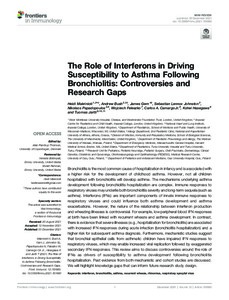The Role of Interferons in Driving Susceptibility to Asthma Following Bronchiolitis: Controversies and Research Gaps
Makrinioti Heidi; Hasegawa Kohei; Papadopoulos Nikolaos; Jartti Tuomas; Johnston Sebastian Lennox; Gern James; Bush Andrew; Camargo Carlos A.; Feleszko Wojciech
https://urn.fi/URN:NBN:fi-fe2022020818065
Tiivistelmä
Bronchiolitis is the most common cause of hospitalization in infancy and is associated with a higher risk for the development of childhood asthma. However, not all children hospitalized with bronchiolitis will develop asthma. The mechanisms underlying asthma development following bronchiolitis hospitalization are complex. Immune responses to respiratory viruses may underlie both bronchiolitis severity and long-term sequela (such as asthma). Interferons (IFNs) are important components of innate immune responses to respiratory viruses and could influence both asthma development and asthma exacerbations. However, the nature of the relationship between interferon production and wheezing illnesses is controversial. For example, low peripheral blood IFN responses at birth have been linked with recurrent wheeze and asthma development. In contrast, there is evidence that severe illnesses (e.g., hospitalization for bronchiolitis) are associated with increased IFN responses during acute infection (bronchiolitis hospitalization) and a higher risk for subsequent asthma diagnosis. Furthermore, mechanistic studies suggest that bronchial epithelial cells from asthmatic children have impaired IFN responses to respiratory viruses, which may enable increased viral replication followed by exaggerated secondary IFN responses. This review aims to discuss controversies around the role of IFNs as drivers of susceptibility to asthma development following bronchiolitis hospitalization. Past evidence from both mechanistic and cohort studies are discussed. We will highlight knowledge gaps that can inform future research study design.
Kokoelmat
- Rinnakkaistallenteet [19207]
